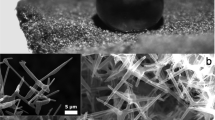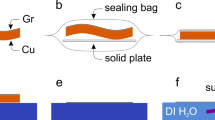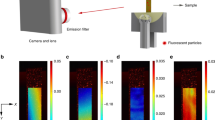Abstract
We report that graphene coatings do not significantly disrupt the intrinsic wetting behaviour of surfaces for which surface–water interactions are dominated by van der Waals forces. Our contact angle measurements indicate that a graphene monolayer is wetting-transparent to copper, gold or silicon, but not glass, for which the wettability is dominated by short-range chemical bonding. With increasing number of graphene layers, the contact angle of water on copper gradually transitions towards the bulk graphite value, which is reached for ~6 graphene layers. Molecular dynamics simulations and theoretical predictions confirm our measurements and indicate that graphene’s wetting transparency is related to its extreme thinness. We also show a 30–40% increase in condensation heat transfer on copper, as a result of the ability of the graphene coating to suppress copper oxidation without disrupting the intrinsic wettability of the surface. Such an ability to independently tune the properties of surfaces without disrupting their wetting response could have important implications in the design of conducting, conformal and impermeable surface coatings.
This is a preview of subscription content, access via your institution
Access options
Subscribe to this journal
Receive 12 print issues and online access
$259.00 per year
only $21.58 per issue
Buy this article
- Purchase on Springer Link
- Instant access to full article PDF
Prices may be subject to local taxes which are calculated during checkout





Similar content being viewed by others
References
Geim, A. K. & Novoselov, K. S. The rise of graphene. Nature Mater. 6, 183–191 (2007).
Lee, C., Wei, X., Kysar, J. W. & Hone, J. Measurement of the elastic properties and intrinsic strength of monolayer graphene. Science 321, 385–388 (2008).
Nair, R. R. et al. Fine structure constant defines visual transparency of graphene. Science 320, 1308 (2008).
Bonaccorso, F., Sun, Z., Hasan, T. & Ferrari, A. C. Graphene photonics and optoelectronics. Nature Photon. 4, 611–620 (2010).
Roddaro, S., Pingue, P., Piazza, V., Pellegrini, V. & Beltram, F. The optical visibility of graphene: Interference colors of ultrathin graphite on SiO2 . Nano Lett. 7, 2707–2710 (2007).
Chen, Z. P. et al. Three-dimensional flexible and conductive interconnected graphene networks grown by chemical vapour deposition. Nature Mater. 10, 424–428 (2011).
Li, X. et al. Highly conducting graphene sheets and Langmuir–Blodgett films. Nature Nanotech. 3, 538–542 (2008).
Li, X. S. et al. Large-area synthesis of high quality and uniform graphene films on Cu foils. Science 324, 1312–1314 (2009).
Li, X. et al. Transfer of large-area graphene films for high-performance transparent conductive electrodes. Nano Lett. 9, 4359–4363 (2009).
Bae, S. et al. Roll-to-roll production of 30-inch graphene films for transparent electrodes. Nature Nanotech. 5, 574–578 (2010).
Eda, G., Fanchini, G. & Chhowalla, M. Large-area ultrathin films of reduced graphene oxide as a transparent and flexible electronic material. Nature Nanotech. 3, 270–274 (2008).
Yavari, F. et al. Tunable bandgap in graphene by the controlled adsorption of water molecules. Small 6, 2535–2538 (2010).
Rafiee, J., Rafiee, M. A., Yu, Z. Z. & Koratkar, N. Superhydrophobic to superhydrophilic wetting control in graphene films. Adv. Mater. 22, 2151–2154 (2010).
Dhiman, P. et al. Harvesting energy from water flow over graphene. Nano Lett. 11, 3123–3127 (2011).
Sansotera, M. et al. Preparation and characterization of superhydrophobic conductive fluorinated carbon blacks. Carbon 48, 4382–4390 (2010).
Han, J. T., Kim, S. Y., Woo, J. S. & Lee, G. W. Transparent, conductive, and superhydrophobic films from stabilized carbon nanotube/silane sol mixture solution. Adv. Mater. 20, 3724–3727 (2008).
Zou, J. et al. Preparation of a superhydrophobic and conductive nanocomposite coating from a carbon-nanotube-conjugated block copolymer dispersion. Adv. Mater. 20, 3337–3341 (2008).
Darmanin, T. & Guittard, F. Molecular design of conductive polymers to modulate super-oleophobic properties. J. Am. Chem. Soc. 131, 7928–7933 (2009).
Srivastava, A. et al. Novel liquid precursor-based facile synthesis of large-area continuous, single, and few-layer graphene films. Chem. Mater. 22, 3457–3461 (2010).
Ferrari, A. C. et al. Raman spectrum of graphene and graphene layers. Phys. Rev. Lett. 97, 187401 (2006).
Werder, T., Walther, J. H., Jaffe, R. L., Halicioglu, T. & Koumoutsakos, P. On the water–carbon interaction for use in molecular dynamics simulations of graphite and carbon nanotubes. J. Phys. Chem. B 107, 1345–1352 (2003).
Zhu, S. B., Fillingim, T. G. & Robinson, G. W. Flexible simple point-charge water in a self-supporting thin film. J. Phys. Chem. 95, 1002–1006 (1991).
Wang, J. Y., Betelu, S. & Law, B. M. Line tension approaching a first-order wetting transition: Experimental results from contact angle measurements. Phys. Rev. E 63, 031601 (2001).
Israelachvili, J. N. Intermolecular and Surface Forces, 2nd edn: With Applications to Colloidal and Biological Systems (Academic, 1992).
Seemann, R., Herminghaus, S. & Jacobs, K. Dewetting patterns and molecular forces: A reconciliation. Phys. Rev. Lett. 86, 5534–5537 (2001).
De Gennes, P. G. Wetting: Statics and dynamics. Rev. Mod. Phys. 57, 827–863 (1985).
Seemann, R., Herminghaus, S. & Jacobs, K. Gaining control of pattern formation of dewetting liquid films. J. Phys. Condens. Matter. 13, 4925–4938 (2001).
Rajter, R. F., French, R. H., Ching, W. Y., Carter, W. C. & Chiang, Y. M. Calculating van der Waals–London dispersion spectra and Hamaker coefficients of carbon nanotubes in water from ab initio optical properties. J. Appl. Phys. 101, 054303 (2007).
Chen, S. et al. Oxidation resistance of graphene-coated Cu and Cu/Ni alloy. ACS Nano 5, 1321–1327 (2011).
Chen, X. et al. Nanograssed micropyramidal architectures for continuous dropwise condensation. Adv. Funct. Mater. 24, 4617–4623 (2011).
Acknowledgements
N.A.K., P.M.A. and Y.S. thank the Advanced Energy Consortium (AEC) for funding support. N.A.K. also acknowledges funding from the USA National Science Foundation (Awards CMMI-1130215 and CBET-0853785). P.M.A. also acknowledges support from the ONR graphene MURI program. We thank Y. Peles at RPI for providing us access to the condensation heat-transfer test facility in his Lab.
Author information
Authors and Affiliations
Contributions
N.A.K. and P.M.A. designed and directed the research. J.R. performed the wetting measurements and optical microscopy. H.G. fabricated the graphene samples on the various substrates. F.Y. performed the Raman characterization of the samples. A.V.T. and N.A.K. performed the condensation heat-transfer measurements. X.M. and Y.S. performed the MD simulations. X.M., Y.S. and N.A.K. carried out the continuum modelling. N.A.K., P.M.A. and Y.S. wrote the paper.
Corresponding authors
Ethics declarations
Competing interests
The authors declare no competing financial interests.
Supplementary information
Supplementary Information
Supplementary Information (PDF 520 kb)
Rights and permissions
About this article
Cite this article
Rafiee, J., Mi, X., Gullapalli, H. et al. Wetting transparency of graphene. Nature Mater 11, 217–222 (2012). https://doi.org/10.1038/nmat3228
Received:
Accepted:
Published:
Issue Date:
DOI: https://doi.org/10.1038/nmat3228
This article is cited by
-
Unveiling the mechanism of remote epitaxy of crystalline semiconductors on 2D materials-coated substrates
Nano Convergence (2023)
-
Moderate binding of villin headpiece protein to C3N3 nanosheet reveals the suitable biocompatibility of this nanomaterial
Scientific Reports (2023)
-
Structure evolution at the gate-tunable suspended graphene–water interface
Nature (2023)
-
Utilisation of heat-treated single-layer graphene as an electrode for hybrid solar cell applications
Applied Physics A (2023)
-
A comprehensive review of graphene-based aerogels for biomedical applications. The impact of synthesis parameters onto material microstructure and porosity
Archives of Civil and Mechanical Engineering (2023)



